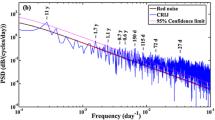Abstract
The station-ring method makes it possible to isolate and study the specific angular distributions of cosmic-ray variations that are poorly described by the sum of the first spherical harmonics. Examples of the use of the station-ring method are given and described in detail. The application of the method to study precursors of Forbush effects and the behavior of cosmic rays inside the perturbations of the solar wind is shown.








Similar content being viewed by others
REFERENCES
Abunin, A.A., Abunina, M.A., Belov, A.V., et al., Forbush-effects with a sudden and gradual onset, Geomagn. Aeron. (Engl. Transl.), 2012, vol. 52, no. 3, pp. 271–291.
Abunina, M.A., Belov, A.V., Eroshenko, E.A., Abunin, A.A., Oleneva, V.A., Yanke, V.G., and Melkumyan, A.A., Ring of station method in research of cosmic ray variations: 1. General description, Geomagn. Aeron. (Engl. Transl.), 2020, vol. 60, no. 1, pp. 38–45.
Belov, A.V., Forbush effects and their connection with solar, interplanetary and geomagnetic phenomena, Proc. IAU Symp., 2009, vol. 257, pp. 439–450.
Belov, A.V., Dorman, L.I., Eroshenko, E.A., Iucci, N., Villoresi, G., and Yanke, V.G., Search for predictors of Forbush decreases, in Proc. 24th ICRC, Rome, 1995, vol. 4, pp. 888–891.
Belov, A.V., Bieber, J.W., Eroshenko, E.A., Evenson, P., Pyle, R., and Yanke, V.G., Pitch-angle features in cosmic rays in advance of severe magnetic storms: Neutron monitor observations, in Proc. 27th ICRC, Hamburg, 2001, pp. 3507–3510.
Belov, A., Abunin, A., Abunina, M., Eroshenko, E., Oleneva, V., Yanke, V., Papaioannou, A., Mavromichalaki, H., Gopalswamy, N., and Yashiro, S., Coronal mass ejections and non-recurrent Forbush decreases, Sol. Phys., 2014, vol. 289, pp. 3949–3960.
Belov, A.V., Eroshenko, E.A., Yanke, V.G., et al., Global survey method for the world network of neutron monitors, Geomagn. Aeron. (Engl. Transl.), 2018, vol. 58, no. 3, pp. 356–372.
Bothmer, V. and Zhukov, A., The Sun as the prime source of space weather, in Space Weather, Physics and Effects, Bothmer, V. and Daglis, I.A., Eds., Springer, 2007, pp. 31–102.
Cane, H.V., Coronal mass ejections and Forbush decreases, Space Sci. Rev., 2000, vol. 93, pp. 55–77.
Dorman, L., Kaminer, N., and Kuz’micheva, A., Spatiotemporal changes in cosmic ray intensity increases before Forbush-decreases, Geomagn. Aeron., 1972, vol. 12, no. 5, pp. 814–822.
Dorman, L.I., Cosmic Rays: Variations and Space Explorations, Amsterdam: North-Holland, 1974.
Dorman, L.I., Space weather and dangerous phenomena on the Earth: Principles of great geomagnetic storms forecasting by online cosmic ray data, Ann. Geophys., 2005, vol. 23, no. 9, pp. 2997–3002.
Gopalswamy, N., Coronal mass ejections and space weather, Climate and Weather of the Sun–Earth System (CAWSES): Selected Papers from the 2007 Kyoto Symposium, Tsuda, T., Fujii, R., Shibata, K., and Geller, M.A., Eds., Tokyo: Terrapub, 2009, pp. 77–120.
Kaminer, H.C., Kuz’micheva, A.E., and Mymrina, H.B., Energy spectrum of the effect of cosmic ray increase before Forbush-decreases, Geomagn. Aeron., 1981, vol. 21, no. 2, pp. 358–359.
Kryakunova, O., Belov, A., Abunin, A., Abunina, M., Eroshenko, E., Malimbayev, A., Tsepakina, I., and Yanke, V., Recurrent and sporadic Forbush-effects in deep solar minimum, J. Phys.: Conf. Ser., 2015, vol. 632. https://doi.org/10.1088/1742-6596/632/1/012062
Kudela, K. and Storini, M., Possible tools for space weather issues from cosmic ray continuous records, Adv. Space Res., 2006, vol. 37, no. 8, pp. 1443–1449.
Leerungnavarat, K., Ruffolo, D., and Bieber, J.W., Loss cone precursors to Forbush decreases and advance warning of space weather effects, Astrophys. J., 2003, vol. 593, pp. 587–596.
Lockwood, J.A., Forbush decreases in the cosmic radiation, Space Sci. Rev., 1971, vol. 12, pp. 658–715.
Mavromichalaki, H., Papaioannou, A., Gerontidou, M., Papailiou, M., Plainaki, C., Belov, A., Eroshenko, E., Abunin, A., Abunina, M., and Yanke, V., Cosmic ray events in the beginning of 2012, J. Phys.: Conf. Ser., 2013, vol. 409. https://doi.org/10.1088/1742-6596/409/1/012206
Nagashima, K., Sakakibara, S., Fujimoto, K., Tatsuoka, R., and Morishita, I., Localized pits and peaks in Forbush decrease, associated with stratified structure of disturbed and undisturbed magnetic fields, Nuovo Cimento C, 1990, vol. 13, pp. 551–587.
Nagashima, K., Fujimoto, K., and Morishita, I., Interplanetary magnetic field collimated cosmic ray flow across magnetic shock from inside of Forbush decrease, observed as local-time-dependent precursory decrease on the ground, J. Geophys. Res., 1994, vol. 99, no. A11, pp. 21 419–21 427.
Papailiou, M., Mavromichalaki, H., Belov, A., Eroshenko, E., and Yanke, V., Precursor effects in different cases of Forbush decreases, Sol. Phys., 2012a, vol. 276, nos. 1–2, pp. 337–350.
Papailiou, M., Mavromichalaki, H., Belov, A., Eroshenko, E., and Yanke, V., The asymptotic longitudinal cosmic ray intensity distribution as a precursor of Forbush decreases, Sol. Phys., 2012b, vol. 280, no. 2, pp. 641–650.
Papailiou, M., Mavromichalaki, H., Abunina, M., Belov, A., Eroshenko, E., Yanke, V., and Kryakunova, O., Forbush decreases associated with western solar sources and geomagnetic storms: A study on precursors, Sol. Phys., 2013, vol. 283, no. 2, pp. 557–563.
Shah, G., Kaul, C., Razdan, H., and Kaul, S., Causes of Forbush decreases, in Proc. 17th ICRC, Paris, 1981, vol. 4, pp. 21–24.
ACKNOWLEDGMENTS
The authors are grateful to the teams of the world network of CR stations providing data for the continuous recording of the neutron component (http://cr0.izmiran.ru/ ThankYou/Our_Acknowledgment.pdf) and to the Neutron Monitor Database (www.nmdb.eu). The work is based on experimental data from the Unique Scientific Facility “Russian National Network of Cosmic Ray Stations.”
Funding
This work was partially supported by the Fundamental Research Program of the Presidium of the Russian Academy of Sciences no. 3 and the Russian Foundation for Basic Research (grant nos. 17-02-00508 and RNF no. 15-12-20001).
Author information
Authors and Affiliations
Corresponding authors
Rights and permissions
About this article
Cite this article
Abunina, M.A., Belov, A.V., Eroshenko, E.A. et al. Station-Ring Method in the Study of Cosmic-Ray Variations: 2. Examples of Its Use. Geomagn. Aeron. 60, 184–191 (2020). https://doi.org/10.1134/S0016793220020024
Received:
Revised:
Accepted:
Published:
Issue Date:
DOI: https://doi.org/10.1134/S0016793220020024




